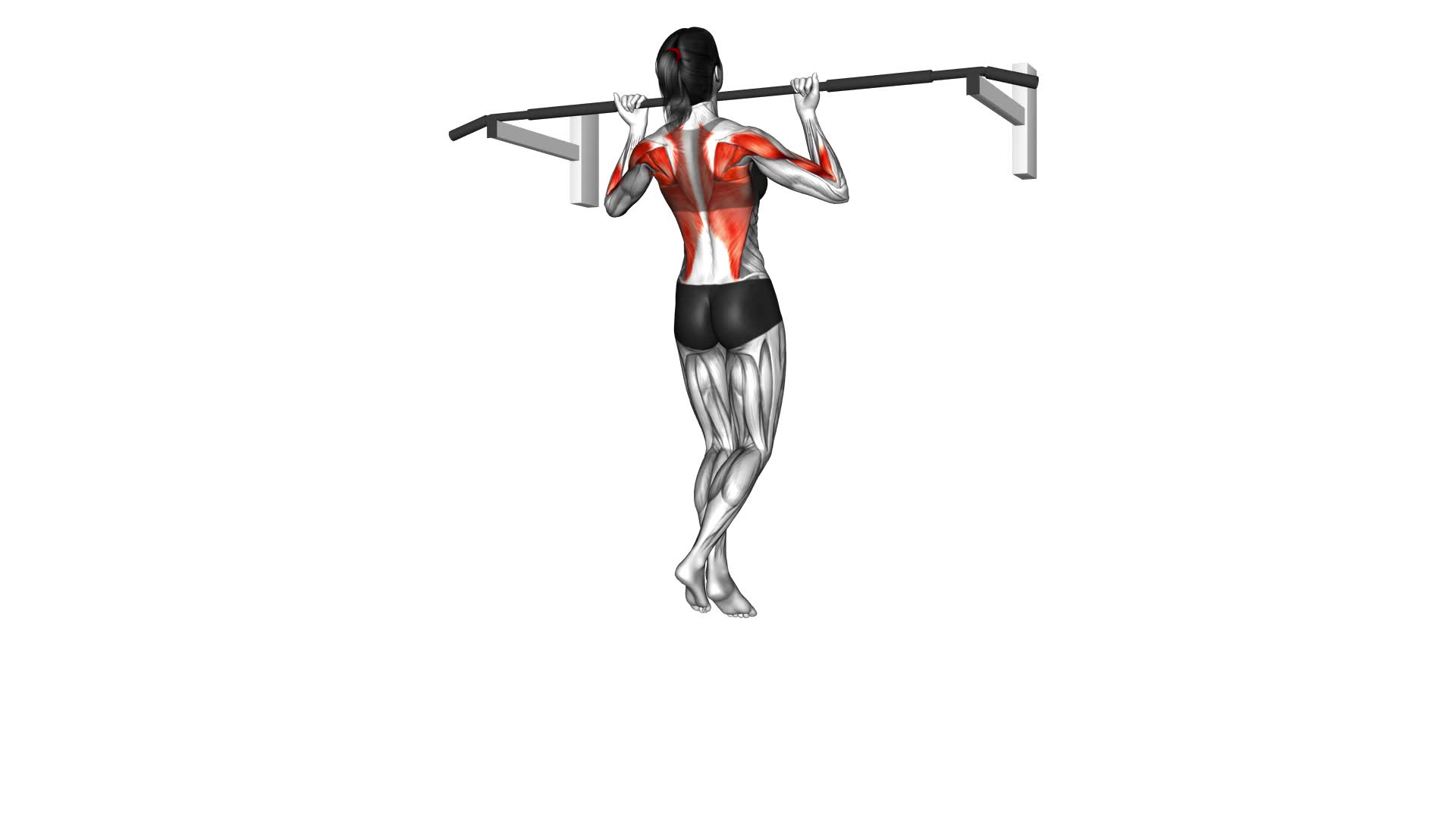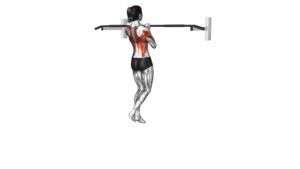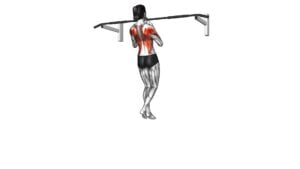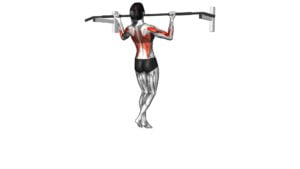Chin-Up (female) – Video Exercise Guide & Tips

Are you a woman looking to improve your upper body strength and tone your arms? Look no further! Our chin-up video exercise guide and tips are here to help you achieve your fitness goals.
Watch This Exercise Video
With proper form and technique, along with variations for different fitness levels, you'll be able to master this challenging exercise.
We'll also provide you with common mistakes to avoid and tips for increasing your chin-up reps.
Get ready to incorporate chin-ups into your workout routine and see amazing results!
Key Takeaways
- Chin-ups for women provide progressive overload and build strength gradually.
- Chin-ups can boost self-confidence, improve body image, and provide a sense of empowerment.
- Proper form and technique, such as focusing on grip positions and avoiding common mistakes, are crucial for maximizing results and avoiding injuries.
- Chin-ups engage back, biceps, and shoulders, providing a comprehensive upper body workout.
Benefits of Chin-Ups for Women
Discover the remarkable benefits you can reap as a woman when you incorporate chin-ups into your fitness routine.
One of the key aspects of chin-up training is the importance of progressive overload. This means gradually increasing the difficulty of your chin-up exercises over time. By challenging your muscles to lift more weight or perform more repetitions, you can build strength and increase your overall fitness level.
In addition to the physical benefits, mastering chin-ups can also have significant mental benefits for women. As you progress in your chin-up training, you'll experience a sense of accomplishment and empowerment. Being able to lift your own body weight can boost your self-confidence and improve your body image. The mental focus required to perform chin-ups can also help to reduce stress and improve mental clarity.
Incorporating chin-ups into your fitness routine can provide you with a challenging and rewarding workout. Not only will you build strength and improve your overall fitness, but you'll also experience mental benefits such as increased self-confidence and reduced stress.
Proper Form and Technique for Chin-Ups
To perform chin-ups with proper form and technique, it's essential to focus on three key points: grip positions, common mistakes, and the muscles worked.
By choosing the right grip position, such as underhand or overhand, you can target different muscle groups and prevent strain.
Avoid common mistakes like using momentum or not fully extending your arms, as these can compromise the effectiveness of the exercise.
Lastly, chin-ups engage multiple muscles, including the back, biceps, and shoulders, making it a great compound exercise for overall upper body strength.
Grip Positions
To perform chin-ups with proper form and technique, you should focus on your grip positions. Grip strength plays a crucial role in executing this exercise effectively.
When it comes to hand placement, there are two common options: the overhand grip and the underhand grip. The overhand grip, also known as the pronated grip, involves placing your hands with palms facing away from you. This grip primarily targets your back muscles.
On the other hand, the underhand grip, also known as the supinated grip, involves placing your hands with palms facing towards you. This grip puts more emphasis on your biceps.
Experiment with both grips to find which one feels more comfortable and allows you to perform chin-ups with proper technique.
Remember to maintain a firm grip throughout the exercise to ensure stability and maximize your results.
Common Mistakes
When performing chin-ups, it's important to be aware of common mistakes in order to maintain proper form and technique, while also avoiding injuries.
One common mistake is using momentum to swing your body up, rather than relying on your upper body strength. This not only decreases the effectiveness of the exercise but also puts unnecessary strain on your shoulders and back.
Another mistake isn't fully extending your arms at the bottom of the movement. This can lead to imbalances and potential injuries.
Additionally, avoid hunching your shoulders or rounding your back during the exercise. This can lead to poor posture and strain on your neck and upper back.
Muscles Worked
To properly work the muscles during chin-ups, you need to ensure proper form and technique. Here's how you can target the specific muscle groups and maximize the weightlifting benefits:
- Latissimus dorsi: As you pull yourself up, focus on engaging your lats, the large muscles on the sides of your back.
- Biceps brachii: Your biceps are heavily engaged during chin-ups as they assist in the pulling motion.
- Rhomboids: These muscles located between your shoulder blades are activated to stabilize and retract your scapulae.
- Core muscles: To maintain a stable body position throughout the exercise, your core muscles, including your abs and obliques, work to keep you balanced.
By targeting these muscle groups, chin-ups provide a comprehensive upper body workout.
Now, let's explore variations and modifications for different fitness levels.
Variations and Modifications for Different Fitness Levels
Now let's explore how you can adapt chin-ups based on your fitness level.
There are various modifications available to help you progress or modify the exercise to suit your needs.
Whether you're a beginner or an advanced athlete, there are options to challenge yourself or make the exercise more accessible.
Fitness Level Adaptations
Adjustments can be made to the chin-up exercise to accommodate individuals at different fitness levels. Here are some fitness level progressions and challenges for beginners:
- Assisted Chin-Up: Use a resistance band or have a spotter assist you by holding your feet. This reduces the amount of body weight you have to lift, making it easier to perform the exercise.
- Negative Chin-Up: Start at the top of the chin-up position and slowly lower yourself down. This focuses on the eccentric portion of the movement, which helps build strength.
- Flexed Arm Hang: Jump up to the top position of the chin-up and hold it for as long as you can. This helps to build upper body strength and grip endurance.
- Inverted Row: Lie underneath a bar and pull your chest up towards the bar. This exercise targets the same muscles used in chin-ups but in a horizontal position.
Varied Modifications Available
As you progress in your fitness journey, there are various modifications and variations available to tailor the chin-up exercise to your specific fitness level.
If you're a beginner or struggling with the traditional chin-up, chair modifications can be a great option. By placing a chair under the chin-up bar, you can use your legs to assist with the movement, making it easier to perform.
As you gain strength, you can gradually reduce the assistance from your legs until you're able to perform a full chin-up.
Another modification option is using resistance bands. By attaching a resistance band to the chin-up bar and placing your foot or knee in the band, you can decrease the amount of body weight you're lifting, making it more manageable.
This allows you to gradually build strength and progress to unassisted chin-ups.
Common Mistakes to Avoid During Chin-Ups
To avoid common mistakes during chin-ups, make sure you maintain proper form and engage your muscles throughout the exercise. Here are some key things to keep in mind:
- Improving grip strength: One mistake many people make is neglecting their grip strength. If you find yourself struggling to hold onto the bar, try incorporating exercises that specifically target your grip, such as farmer's walks or using a grip trainer.
- Using assistive bands: If you're just starting out or find chin-ups challenging, using assistive bands can be a great way to gradually build strength. These bands provide support and help you with the upward movement, making it easier to perform the exercise correctly.
- Avoiding swinging or kipping: It's important to maintain control throughout the entire movement. Swinging or using momentum to complete the chin-up not only reduces the effectiveness of the exercise but also increases the risk of injury.
- Not rushing the movement: Take your time and focus on the quality of each repetition. Avoid the temptation to rush through the exercise, as this can compromise your form and limit the benefits you get from the chin-up.
Tips for Increasing Your Chin-Up Reps
To increase your chin-up reps, focus on improving your upper body strength and maintaining proper form throughout the exercise. Here are some tips to help you increase your chin-up reps:
- Gradually increase intensity: Start with a manageable number of reps and gradually increase the intensity over time. This will help to build strength and endurance in your upper body.
- Incorporate resistance training: Include exercises that target the muscles used in chin-ups, such as lat pull-downs, rows, and bicep curls. Strengthening these muscles will make it easier to perform chin-ups.
- Practice negative chin-ups: Start at the top position of the chin-up and slowly lower yourself down. This eccentric movement helps to build strength and control, which can translate to more reps.
- Use assisted chin-up variations: If you're struggling to do full chin-ups, use assisted variations such as using a resistance band or an assisted chin-up machine. These variations can help you build strength and gradually progress to unassisted chin-ups.
- Rest and recover: Allow your muscles to rest and recover between chin-up sessions. This will help prevent overuse injuries and allow your muscles to adapt and grow stronger.
Incorporating Chin-Ups Into Your Workout Routine
To incorporate chin-ups into your workout routine, start by adding them as a challenging upper body exercise. Chin-ups are an effective way to increase upper body strength and build muscle in your back, arms, and shoulders. Here are four tips to help you incorporate chin-ups into your routine:
- Start with assisted chin-ups: If you're new to chin-ups or find them difficult, start by using an assisted chin-up machine or resistance bands. These tools can help take some of the weight off and allow you to perform the exercise with proper form.
- Gradually decrease assistance: As you get stronger, gradually decrease the assistance from the machine or resistance bands. This will increase the intensity of the exercise and help you progress towards unassisted chin-ups.
- Use variations: If you're unable to perform a full chin-up, try variations such as negative chin-ups or inverted rows. These exercises target the same muscle groups and can help build the strength necessary for chin-ups.
- Include chin-ups in your routine: Aim to include chin-ups in your workout routine at least once or twice a week. Start with a few sets of low reps and gradually increase the number of reps as you get stronger.
Frequently Asked Questions
What Are the Different Muscles Targeted During Chin-Ups for Women?
Improving upper body strength is essential for women. Chin-ups are a great exercise for that, as they target various muscles, including the latissimus dorsi, biceps, and rhomboids.
Chin-ups provide numerous benefits for women. They can help tone and strengthen the upper body, improve posture, and increase overall body strength.
Can Chin-Ups Help in Improving Posture for Women?
Improving your posture is crucial, and chin-ups can definitely help with that. By incorporating chin-ups into your strength training routine, you can strengthen the muscles in your back, shoulders, and core, which are all essential for maintaining good posture.
However, it's important to focus on proper form while doing chin-ups to maximize the benefits. Pay attention to your body alignment and engage your core muscles to avoid any strain or injury.
Are There Any Specific Recommendations for Warm-Up Exercises Before Performing Chin-Ups?
Before performing chin-ups, it's important to warm up your muscles properly. Start with dynamic stretches like arm circles and shoulder rolls to get your upper body ready.
Additionally, consider using a foam roller to release any tightness in your back and shoulders. Foam rolling can help improve your range of motion and reduce the risk of injury during chin-ups.
How Long Does It Usually Take to See Results From Regularly Incorporating Chin-Ups Into a Workout Routine?
When you regularly incorporate chin-ups into your workout routine, you might wonder how long it takes to see results. The time it takes to see progress can vary depending on various factors such as your current fitness level, consistency, and proper form.
Beginners can start with assisted chin-ups and gradually increase intensity and repetitions over time. To optimize results, avoid common mistakes like using momentum and not fully engaging your back muscles.
With dedication and proper technique, you can expect to see improvements within a few weeks to a couple of months.
Can Chin-Ups Be Performed by Women With Certain Physical Limitations or Injuries?
Chin-up modifications and alternative upper body exercises can be helpful for women with physical limitations or injuries. It's important to consider your unique situation and consult with a fitness professional or physical therapist to determine the best approach.
They can provide guidance on modifying the exercise or suggest alternative exercises that target the same muscle groups. By adapting your workout routine, you can still work on building strength and achieving your fitness goals.
Conclusion
In conclusion, chin-ups are a highly beneficial exercise for women that can improve upper body strength and overall fitness.
By following proper form and technique, and making use of variations and modifications based on fitness levels, women can safely and effectively perform chin-ups.
Avoiding common mistakes and gradually increasing the number of reps can further enhance results.
Incorporating chin-ups into your workout routine can lead to noticeable improvements in strength and overall physical performance.

Author
Years ago, the spark of my life’s passion ignited in my mind the moment I stepped into the local gym for the first time. The inaugural bead of perspiration, the initial endeavor, the very first surge of endorphins, and a sense of pride that washed over me post-workout marked the beginning of my deep-seated interest in strength sports, fitness, and sports nutrition. This very curiosity blossomed rapidly into a profound fascination, propelling me to earn a Master’s degree in Physical Education from the Academy of Physical Education in Krakow, followed by a Sports Manager diploma from the Jagiellonian University. My journey of growth led me to gain more specialized qualifications, such as being a certified personal trainer with a focus on sports dietetics, a lifeguard, and an instructor for wellness and corrective gymnastics. Theoretical knowledge paired seamlessly with practical experience, reinforcing my belief that the transformation of individuals under my guidance was also a reflection of my personal growth. This belief holds true even today. Each day, I strive to push the boundaries and explore new realms. These realms gently elevate me to greater heights. The unique combination of passion for my field and the continuous quest for growth fuels my drive to break new ground.



